Abstract
B-cell response and suppression of response were analysed with respect to changes in frequency or composition of regulatory elements in comparison to untreated BALB/c mice. As antigenic stimulus the hapten TNP was used. Suppression was induced by intravenous (i.v.) injection of TNP-haptenized syngeneic lymphocytes; for inducing response, mice received TNP-horse red blood cells (HRBC). As the read-out system, plaque-forming cells (PFC) were determined after either the addition of naive B cells only [determination of the frequency of helper T-cells (TH)], or the addition of naive B cells plus saturating doses of TNP-specific TH [determination of the frequency of suppressor T-cells (Ts)]. The data indicate that, in untreated animals, a network of help and suppression is pre-existing, wherein TH are more frequent (1/1471) than TS (1/4413), but TS are dominant, i.e. when the fraction of non-responding cultures (F0) (determination of help) was plotted, an inversion of the curve was seen at high numbers of cells per well; however, the fractions of responding cultures (F+) (determination of suppression) could be plotted on a straight line. Application of antigen in suppressogenic or immunogenic form resulted in a two- to four-fold increase in the corresponding regulatory population but, concomitantly, a minor increase in the frequency of the mutual counteracting population was observed. Irrespective of any immunization schedule, TH were more frequent than TS. The overall shape of the 'helper' and 'suppressor' curves with spleen cells (SC) from suppressed mice resembled--besides changes in the frequencies--those obtained with SC of untreated animals. This corresponds to the maintenance of a state of unresponsiveness as in untreated animals. However, when SC from primed or suppressed plus primed mice were analysed, a different type of curve was obtained. Suppressor curves no longer followed a ratio dominance model; instead, at high numbers of cells per well, the frequency of wells with suppressive activity decreased. Correspondingly, in helper curves, a second slope of increasing numbers of wells with helper activity was seen at a high input of cells. Hence, response cannot be explained solely by expansion/activation of TH, but obviously a third regulatory population is involved which could not be detected in untreated animals. This third regulatory population could either be non-suppressible TH or--more likely, as will be discussed--contrasuppressor cells.
Full text
PDF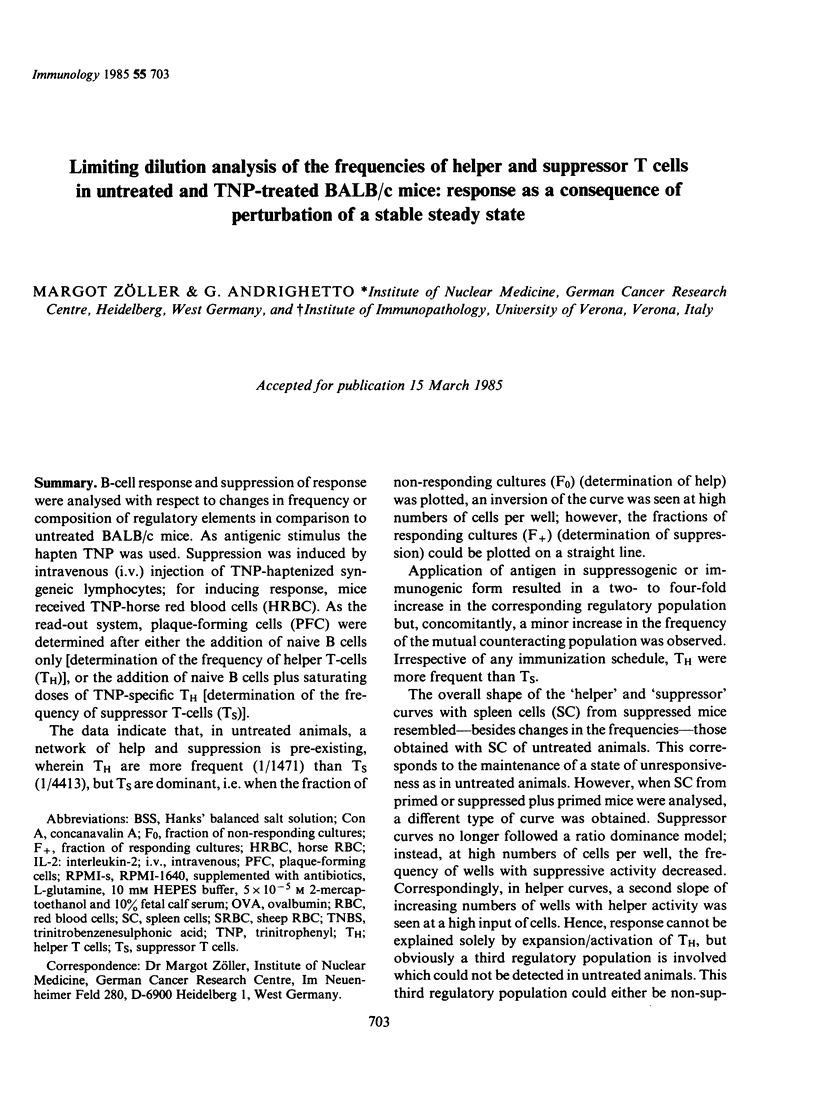
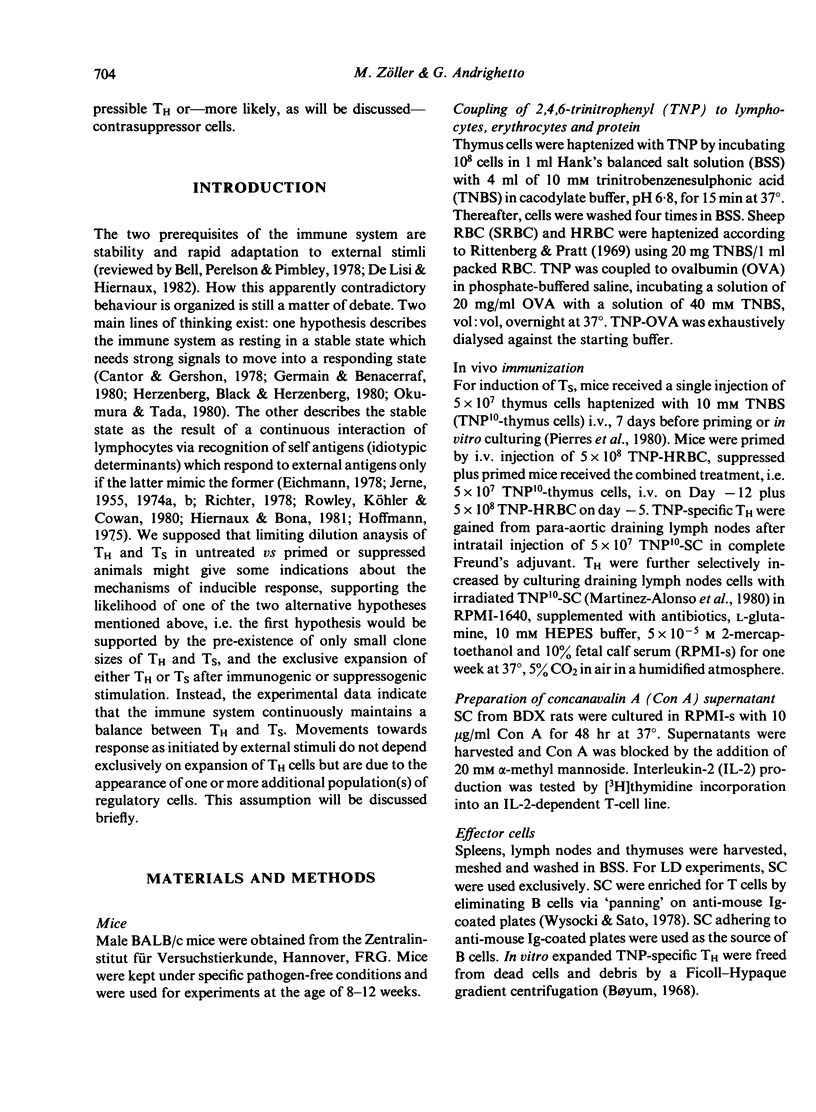
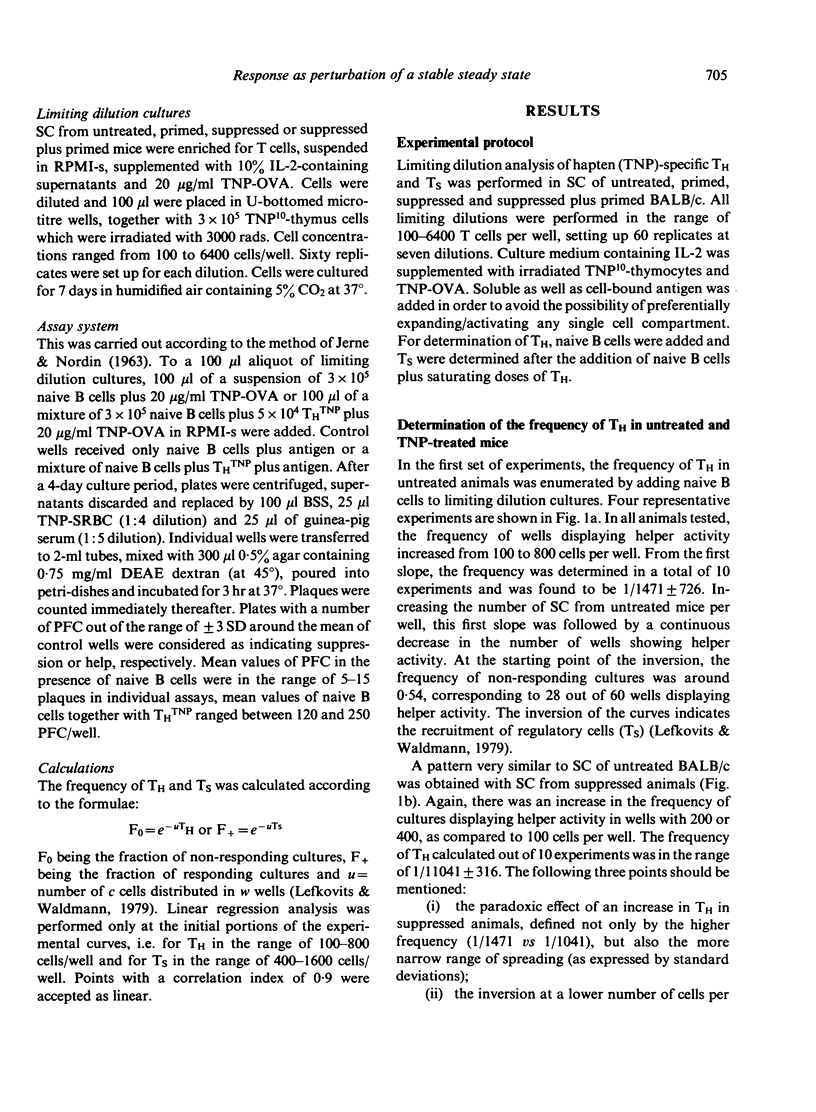

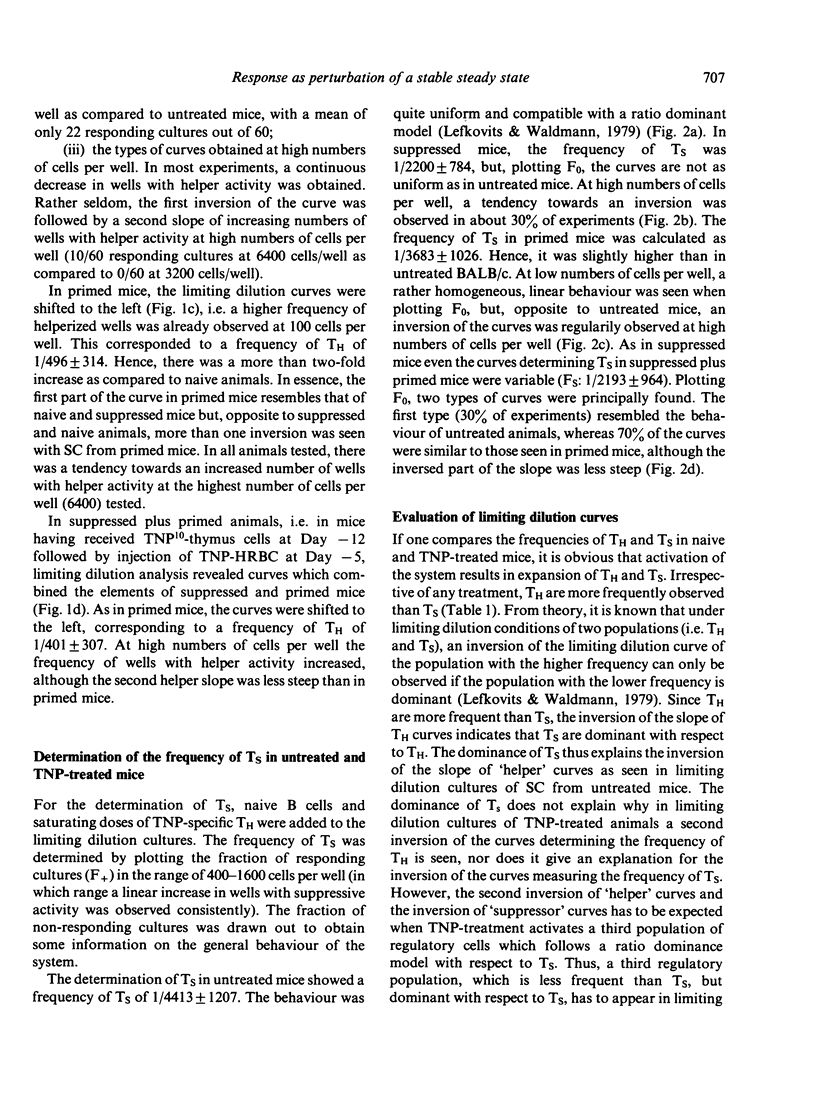

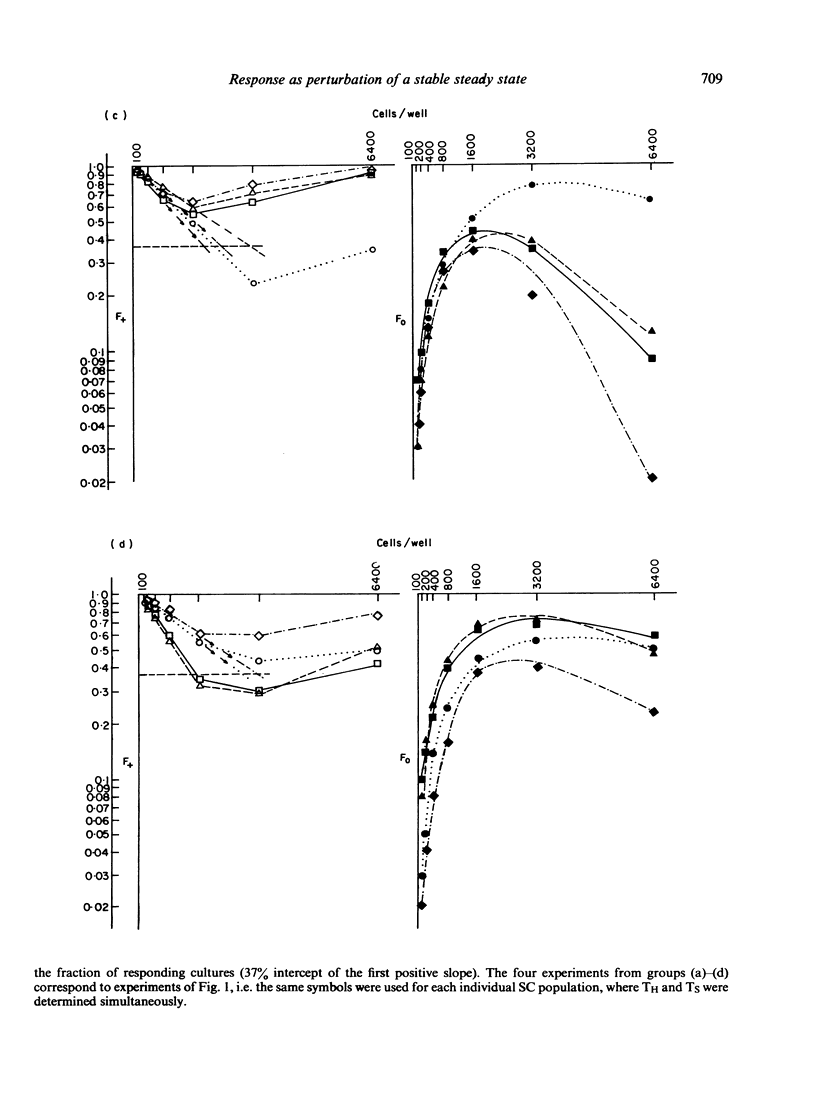
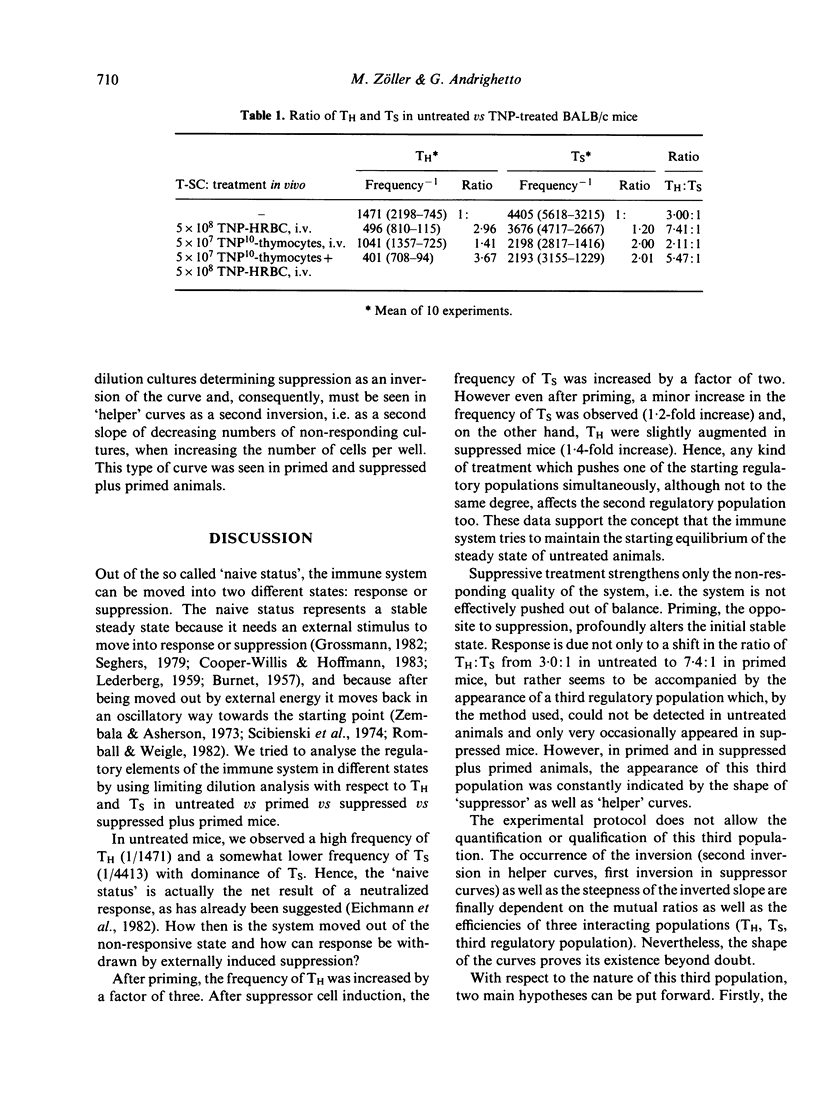
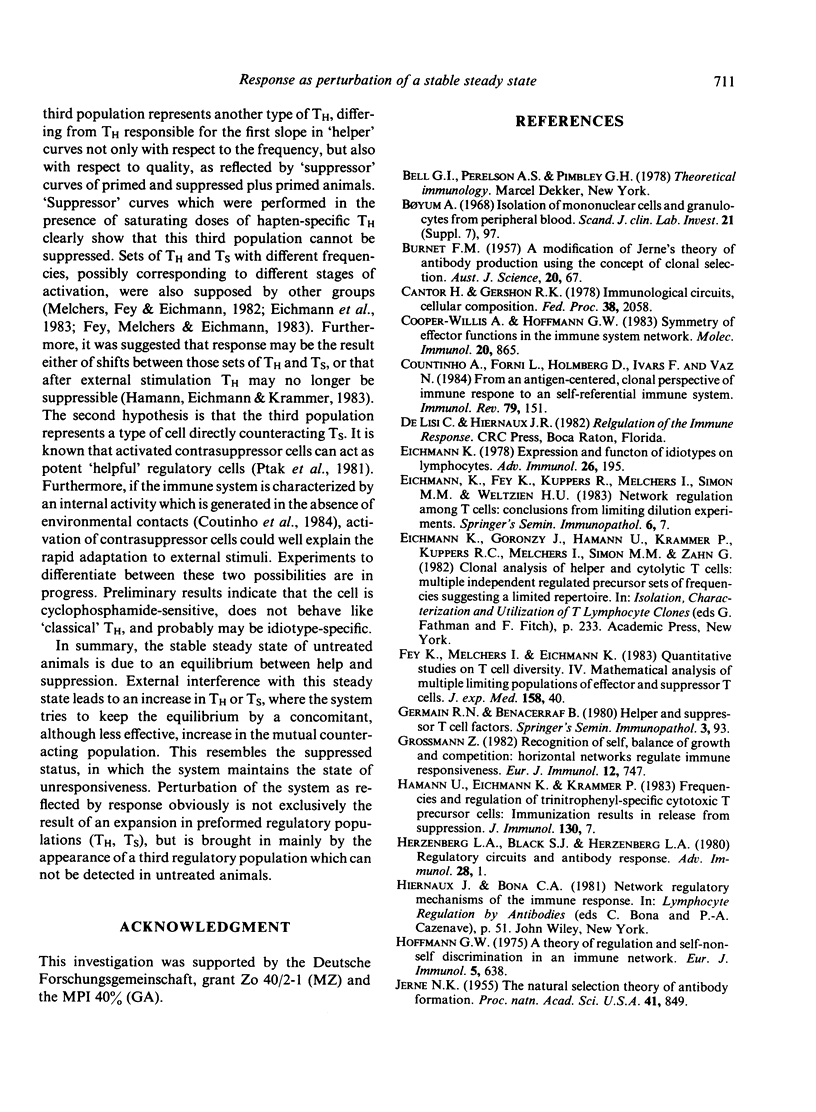

Selected References
These references are in PubMed. This may not be the complete list of references from this article.
- Cantor H., Gershon R. K. Immunological circuits: cellular composition. Fed Proc. 1979 Jun;38(7):2058–2064. [PubMed] [Google Scholar]
- Cooper-Willis A., Hoffmann G. W. Symmetry of effector function in the immune system network. Mol Immunol. 1983 Aug;20(8):865–870. doi: 10.1016/0161-5890(83)90083-4. [DOI] [PubMed] [Google Scholar]
- Coutinho A., Forni L., Holmberg D., Ivars F., Vaz N. From an antigen-centered, clonal perspective of immune responses to an organism-centered, network perspective of autonomous activity in a self-referential immune system. Immunol Rev. 1984 Jun;79:151–168. doi: 10.1111/j.1600-065x.1984.tb00492.x. [DOI] [PubMed] [Google Scholar]
- Eichmann K. Expression and function of idiotypes of lymphocytes. Adv Immunol. 1978;26:195–254. doi: 10.1016/s0065-2776(08)60231-x. [DOI] [PubMed] [Google Scholar]
- Eichmann K., Fey K., Kuppers R., Melchers I., Simon M. M., Weltzien H. U. Network regulation among T cells; conclusions from limiting dilution experiments. Springer Semin Immunopathol. 1983;6(1):7–32. doi: 10.1007/BF01857364. [DOI] [PubMed] [Google Scholar]
- Fey K., Melchers I., Eichmann K. Quantitative studies on T cell diversity. IV. Mathematical analysis of multiple limiting populations of effector and suppressor T cells. J Exp Med. 1983 Jul 1;158(1):40–52. doi: 10.1084/jem.158.1.40. [DOI] [PMC free article] [PubMed] [Google Scholar]
- Germain R. N., Benacerraf B. Helper and suppressor T cell factors. Springer Semin Immunopathol. 1980 May;3(1):93–127. doi: 10.1007/BF00199927. [DOI] [PubMed] [Google Scholar]
- Grossman Z. Recognition of self, balance of growth and competition: horizontal networks regulate immune responsiveness. Eur J Immunol. 1982 Sep;12(9):747–756. doi: 10.1002/eji.1830120909. [DOI] [PubMed] [Google Scholar]
- Hamann U., Eichmann K., Krammer P. H. Frequencies and regulation of trinitrophenyl-specific cytotoxic T precursor cells: immunization results in release from suppression. J Immunol. 1983 Jan;130(1):7–14. [PubMed] [Google Scholar]
- Herzenberg L. A., Black S. J., Herzenberg L. A. Regulatory circuits and antibody responses. Eur J Immunol. 1980 Jan;10(1):1–11. doi: 10.1002/eji.1830100102. [DOI] [PubMed] [Google Scholar]
- Hoffmann G. W. A theory of regulation and self-nonself discrimination in an immune network. Eur J Immunol. 1975 Sep;5(9):638–647. doi: 10.1002/eji.1830050912. [DOI] [PubMed] [Google Scholar]
- Jerne N. K., Nordin A. A. Plaque Formation in Agar by Single Antibody-Producing Cells. Science. 1963 Apr 26;140(3565):405–405. doi: 10.1126/science.140.3565.405. [DOI] [PubMed] [Google Scholar]
- Jerne N. K. THE NATURAL-SELECTION THEORY OF ANTIBODY FORMATION. Proc Natl Acad Sci U S A. 1955 Nov 15;41(11):849–857. doi: 10.1073/pnas.41.11.849. [DOI] [PMC free article] [PubMed] [Google Scholar]
- Jerne N. K. The immune system: a web of V-domains. Harvey Lect. 1974 1975;70(SERIES):93–110. [PubMed] [Google Scholar]
- Melchers I., Fey K., Eichmann K. Quantitative studies on T cell diversity. III. Limiting dilution analysis of precursor cells for T helper cells reactive to xenogeneic erythrocytes. J Exp Med. 1982 Dec 1;156(6):1587–1603. doi: 10.1084/jem.156.6.1587. [DOI] [PMC free article] [PubMed] [Google Scholar]
- Pierres A., Bromberg J. S., Sy M. S., Benacerraf B., Greene M. I. Mechanisms of regulation of cell-mediated immunity. VI. Antigen density dependence of the induction of genetically restricted suppressor cells. J Immunol. 1980 Jan;124(1):343–348. [PubMed] [Google Scholar]
- Ptak W., Green D. R., Durum S. K., Kimura A., Murphy D. B., Gershon R. K. Immunoregulatory circuits which modulate responsiveness to suppressor cell signals: contrasuppressor cells can convert an in vivo tolerogenic signal into an immunogenic one. Eur J Immunol. 1981 Dec;11(12):980–983. doi: 10.1002/eji.1830111206. [DOI] [PubMed] [Google Scholar]
- Rittenberg M. B., Pratt K. L. Antitrinitrophenyl (TNP) plaque assay. Primary response of Balb/c mice to soluble and particulate immunogen. Proc Soc Exp Biol Med. 1969 Nov;132(2):575–581. doi: 10.3181/00379727-132-34264. [DOI] [PubMed] [Google Scholar]
- Scibienski R. J., Harris L. M., Fong S., Benjamini E. Active and inactive states of immunologic unresponsiveness. J Immunol. 1974 Jul;113(1):45–50. [PubMed] [Google Scholar]
- Seghers M. A qualitative study of an idiotypic cyclic network. J Theor Biol. 1979 Oct 22;80(4):553–576. doi: 10.1016/0022-5193(79)90093-6. [DOI] [PubMed] [Google Scholar]
- Tada T., Okumura K. The role of antigen-specific T cell factors in the immune response. Adv Immunol. 1979;28:1–87. doi: 10.1016/s0065-2776(08)60799-3. [DOI] [PubMed] [Google Scholar]
- Wysocki L. J., Sato V. L. "Panning" for lymphocytes: a method for cell selection. Proc Natl Acad Sci U S A. 1978 Jun;75(6):2844–2848. doi: 10.1073/pnas.75.6.2844. [DOI] [PMC free article] [PubMed] [Google Scholar]
- Zembala M., Asherson G. L. Depression of the T cell phenomenon of contact sensitivity by T cells from unresponsive mice. Nature. 1973 Jul 27;244(5413):227–228. doi: 10.1038/244227a0. [DOI] [PubMed] [Google Scholar]


